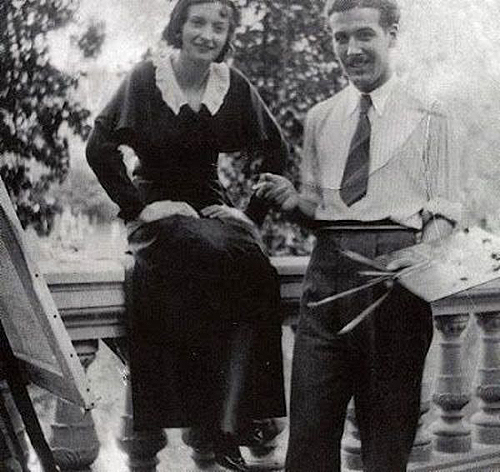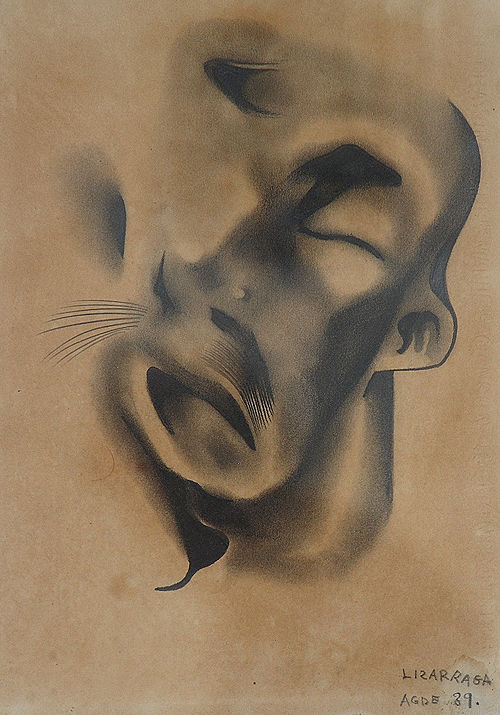The piece of the month of January 2017
ANGUSTIA, DRAWING BY GERARDO LIZARRAGA
José Mª Muruzábal del Solar
PhD in History of Art
"Anguish."
Charcoal / paper. 32 x cm. Signed in AGDE, 1939.
LIZARRAGA, Gerardo (Pamplona, 1905 - 1983).
Gerardo Lizarraga Istúriz was born in Pamplona in 1905. He studied with Javier Ciga, with Julio Briñol, Elena Goicoechea and Pedro Lozano de Sotés. He later studied at San Fernando in Madrid, where he was student with Cecilio Pla, Manuel Benedito and Romero de Torres, as well as with Remedios Varo, José Luis Florit, Francis Bartolozzi, Adela Tejero, Pilar Gamonae and Pedro Lozano de Sotés, with whom he shared a student flat together with Leocadio Muro Urriza. He meets Salvador Dalí and Maruja Mayo, who belong to the year before him. He obtained the degree scroll teaching diploma in 1928. In 1928 he was granted a scholarship by the Provincial Council of Navarre to study in the French capital. In Paris he was surprised by the work of the Cubists.
In 1932 he married Remedios Varo y Uranga, a fellow pupil of his at the San Fernando Academy. They settled in Barcelona. The Catalan capital was then one of the most prestigious cities in the intellectual and artistic circles of Europe. There, Gerardo developed all his creative possibilities. He was employed as a set designer for the opera "Pedro Mari (Canción de libertad)", which was staged at the Teatro del Liceo, and later toured the whole of Catalonia. He founds the Sindicato de Dibujantes Profesionales de Barcelona and wins first and second prizes in several poster competitions. The Syndicate was affiliated to the UGT. The Civil War took him by surprise in Barcelona, where he took an active part in the Republican side.

Remedios Varo and Gerardo Lizarraga. 1927
At the end of the war he was interned in the refugee camps of Argelés-sur-Mer and Clermont Ferrand, until 1941, when he was liberated thanks to the efforts of his own wife and forcibly transferred to Marseilles, where he managed to recover and exhibit at the Galeries Paradis and the Salle Mirian Michelle the following year. In France, now divorced from Remedios Varo, he is director artist of the Office International de Publicité et Édition. exhibition In 1942 he organises a solo exhibition of his work in Monte Carlo, before leaving France and taking refuge in Mexico.
He later lived for many years in Mexico, where he acquired great artistic renown. Lizarraga, together with other artists, founded the Círculo de Bellas Artes in the capital (1945), dedicated to promote painting, and became its president. He married again, this time to a Spanish refugee from Tudela, presentation Cruchaga Valdemoros, a photographer, known in the world of his specialization programas Ikerne. Their two children were born from this marriage: Amaya, in 1947, and Xabier in 1948. But the second marriage was divorced in 1963. In the 1970s he met Asunción Lazcorreta, a poet and writer who wrote a research about Remedios Varo, whom he decided to marry "with the intention of facilitating the processing of his residency papers", as Gerardo had obtained Mexican nationality. The status does not change until the early 1980s, when they legally divorce. Gerardo died in Mexico City, aged 76, on 3 August 1982.
Gerardo Lizarraga's aesthetic work is wide and varied. Throughout his artistic career, this artist produced oil paintings, drawings, engravings, illustrations, scenographies, etc. The work we present here could be perfectly related to some of the author's engravings published by Javier Zubiaur. These are heartbreaking works, which reveal the tragedy of the exile experienced by this artist from Navarre. The drawing we present here is an authentic cry of human despair, with enormous symbolism and expressionism. Aesthetically, it is constructed with a stroke and technical perfection beyond any doubt. This work demonstrates Gerardo Lizarraga's mastery of drawing. But it is clear that the interest of the work does not lie in this mastery of technique, but in its profound expressiveness. In the foreground, occupying the whole scene, appears that torn male face, in an anguished cry of desperation and tragedy, convulsed, practically surreal. Knowing the author's life journey and his experience of exile in 1939, this work impresses us even more; it seems that Gerardo Lizarraga has managed to literally transfer his experience staff to paper, with an aesthetic force that is very difficult to achieve.

Angustia, by Gerardo Lizarraga, 1939. Charcoal/paper, 32 x cm.
The drawing, perfectly signed, is dated 1939, the year of his exile. We know of the painter's internment in the concentration camps of Argelès-sur-Mer and Clermont Ferrand. Next to signature, written in pencil, appears Agde, which we can identify perfectly. Agde is a French town, located at department de Héraut, in the Occitania region, relatively close to the Spanish border. From the date, it is clear that it is from the time of the Spanish exile after the civil war, perhaps immediately before Gerardo Lizarraga was interned in a concentration camp, where he remained between 1939 and 1941. Be that as it may, it is abundantly clear that we are looking at a drawing that represents the Spanish Republican exile, personified in the figure and work of this distinguished artist from Pamplona.

signature, place and date of drawing
The drawing belongs to our family collection and was acquired, online, about five years ago, in a remote village in the former East Germany. It has always struck us how such a drawing, made in the south of France by an artist from Navarre who was in exile, ended up in such a distant land: did a German soldier pick it up at the time of the Nazi occupation of France and take it there? This is a somewhat cinematographic or novelistic interpretation, but we know that reality often far surpasses fiction. Be that as it may, this drawing has returned to its home, which is Navarre.
BIBLIOGRAPHY
LIZARRAGA, X., "The true story of the painter Lizarraga", Diario de Navarra, 15-II-1987.
ZUBIAUR CARREÑO, F. J., "Gerardo Lizarraga", in Pamplona year 07, Pamplona, Pamplona City Council, 2007, pp. 101-117. Catalog of the exhibition held at the Pamplona Citadel.
ZUBIAUR CARREÑO, F. J., data for a Catalog raisonné of the painter Gerardo Lizarraga Istúriz, published in the web of the author.
